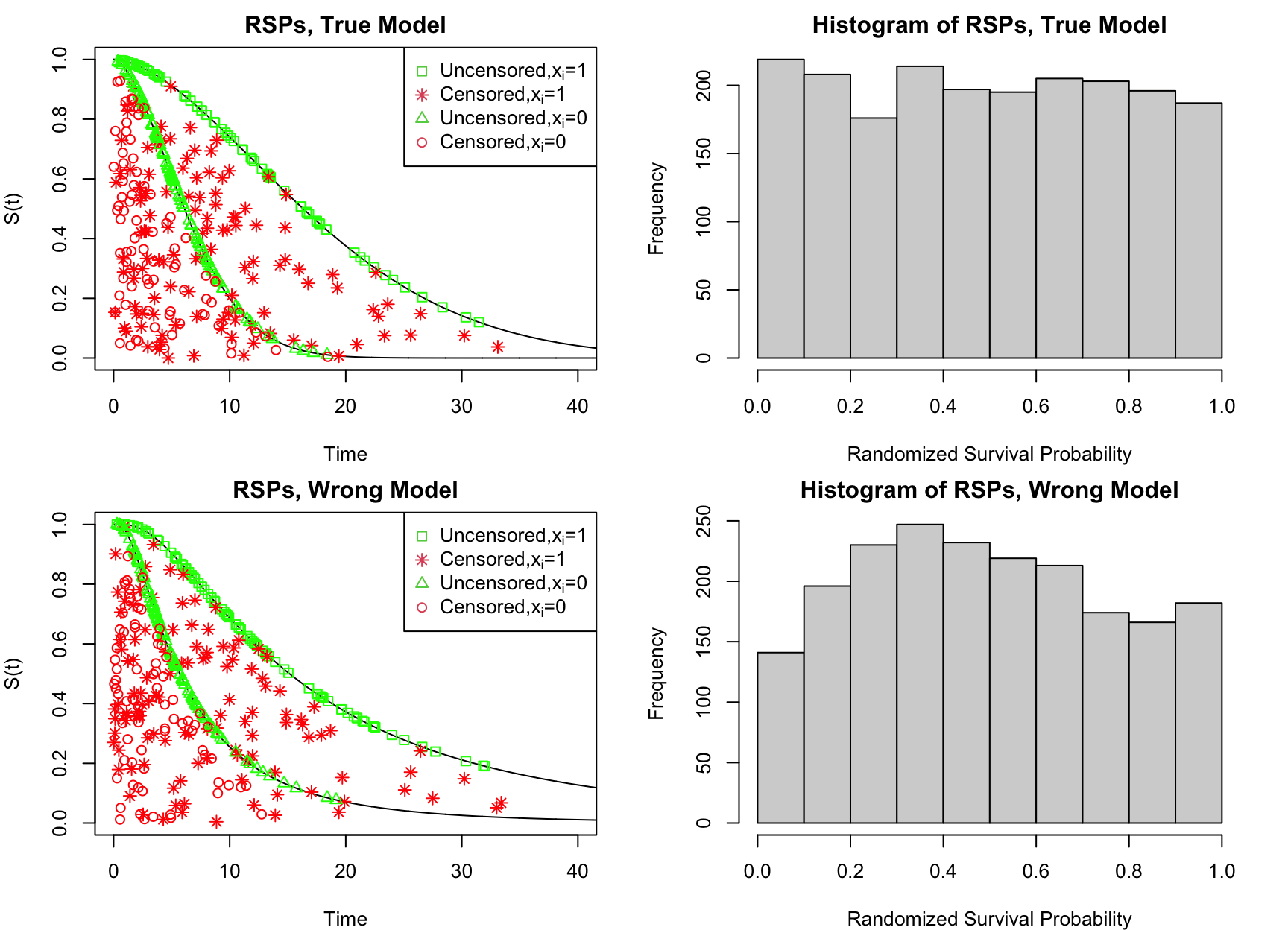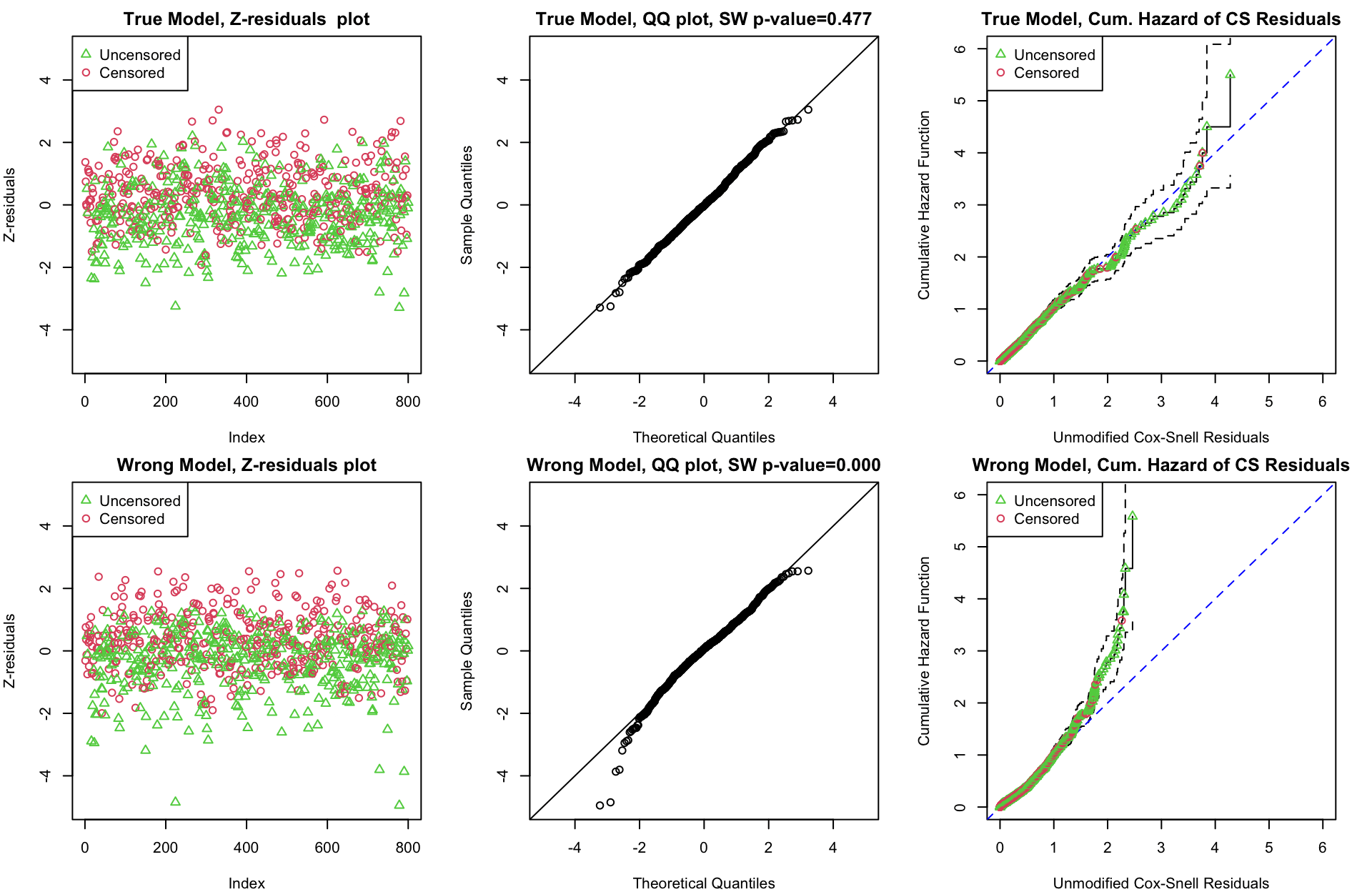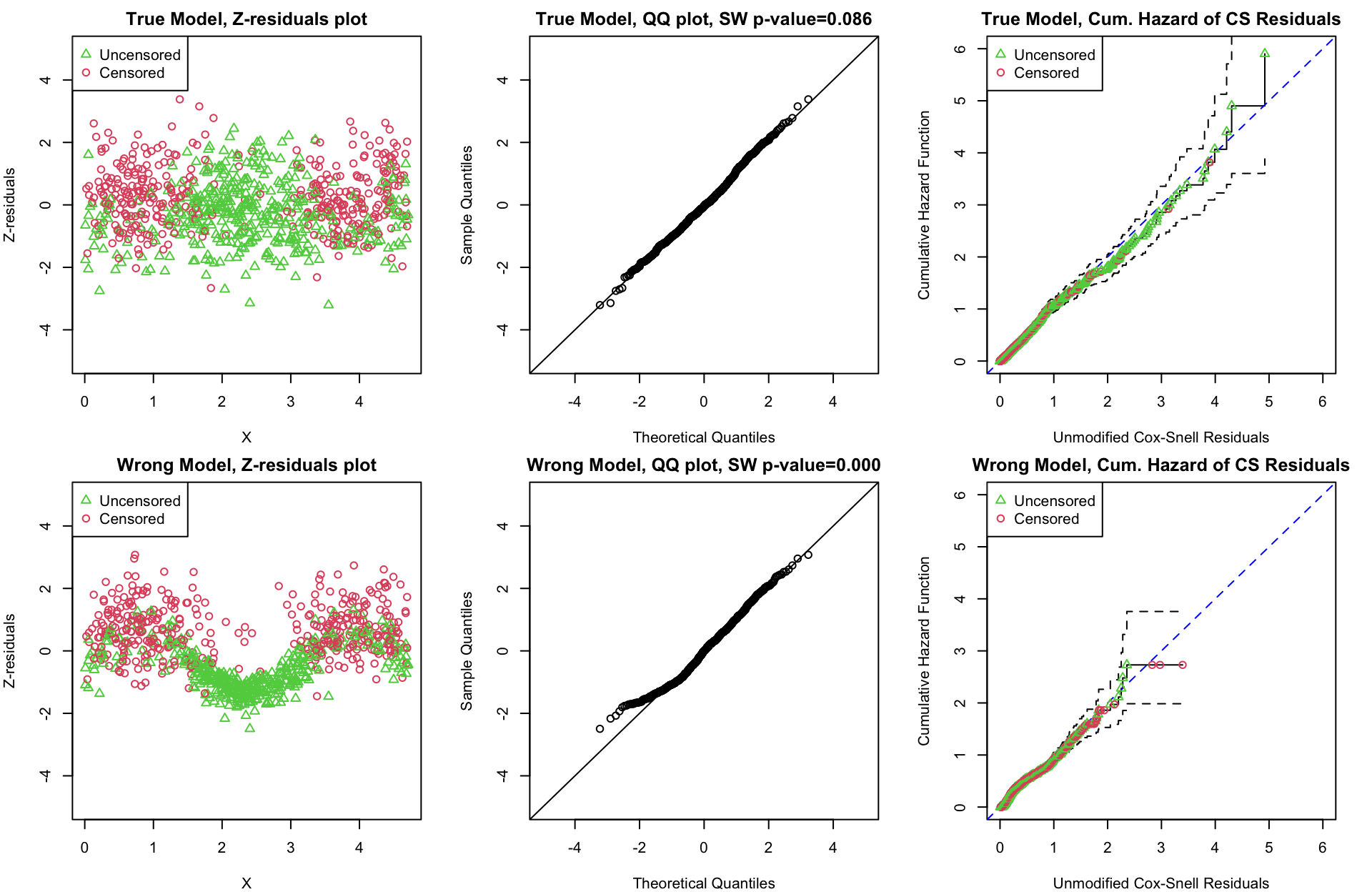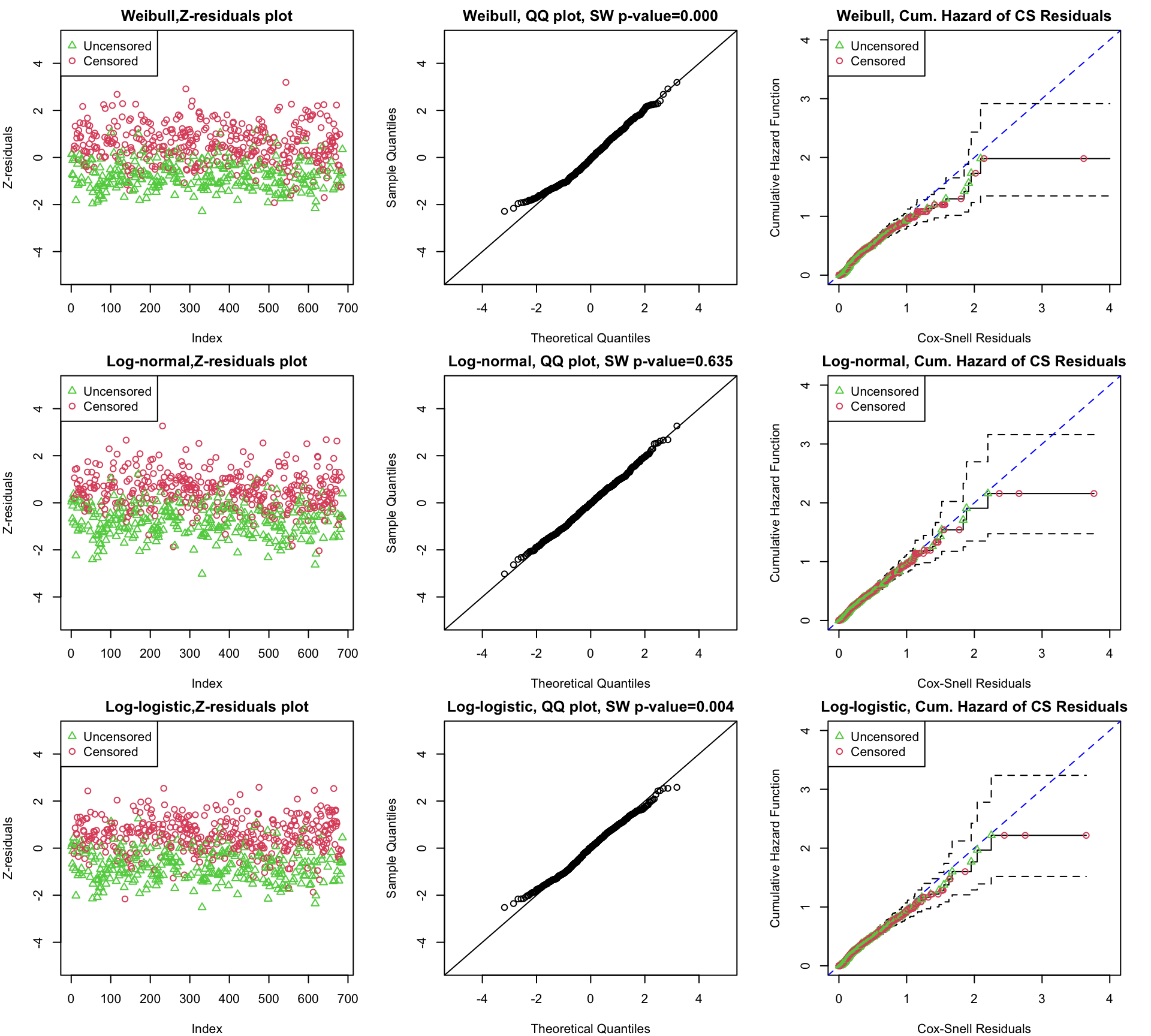R Functions for Computing Z-Residuals for
survreg and coxph Objects
Longhai Li, Department of Mathematics and Statistics, Unviersity of Saskatchewan
May 20, 2025
R Functions for Z-Residuals
What is Z-Residual (NRSP Residual)?
Let t_i be a possibly right-censored observation, \delta_i be the indicator for being uncensored, and \hat{S}_i(\cdot) be an estimated survival function of original uncensored T^*_i given covariate x_i and parameters. The randomized survival probability (RSP) for t_i is defined as: \begin{equation} S_i^{R}(t_i, \delta_i, U_i) = \left\{ \begin{array}{rl} \hat S_{i}(t_i), & \text{if $t_i$ is uncensored, i.e., $\delta_{i}=1$,}\\ U_i\, \hat S_{i}(t_i), & \text{if $t_i$ is censored, i.e., $\delta_i=0$.} \end{array} \right. \end{equation} where U_i is a uniform random number on (0, 1). Li, L., Wu, T., & Feng, C. (2021) shows that RSPs are uniformly distributed on (0,1) under the true model for T^*_i. Therefore, they can be transformed into residuals with any desired distribution. Z-residuals are transformed RSPs with the standard normal quantile: \begin{equation} r_{i}^{\text{Z}}(t_i, \delta_i, U_i)=-\Phi^{-1} (S_{i}^R(t_i, \delta_i, U_i)) \end{equation}
Note that in the original publication by Li et al. (2021), a negative sign was not incorporated into the definition of the Z-residual. Upon further consideration, it was determined that the addition of a negative sign is more appropriate. This modification ensures that larger residuals correspond to larger observed values, which is consistent with the convention for Pearson’s residuals.
Z-residuals are approximately standard normally distributed under the true model with estimated parameters. The approximate normality holds for any censoring distribution. Z-residuals can be used to check the goodness-of-fit of S_i(\cdot) quantitatively by applying SW or other normality tests to Z-residuals, and graphically by visualizing their QQ plots. Other diagnostic methods such as scatterplots and statistical tests can be applied to diagnose the relationship between Z-residuals and covariates. For example, by examining whether the Z-residuals within the k groups are homogeneously distributed, we can assess the functional form of the covariates.
R Functions for Computing Z-residuals
##input: survreg_fit is a survreg object
resid_survreg<-function(survreg_fit)
{
distr<-survreg_fit$dist
y<- survreg_fit$y
m <- nrow (y)
parms<- as.numeric(survreg_fit[["parms"]])
alpha_hat<-1/survreg_fit$scale
if (distr %in% c("weibull","exponential","logistic","lognormal",
"loglogistic","gaussian", "loggaussian","rayleigh"))
{
SP<-1-(psurvreg(as.data.frame(as.matrix(y))[,-2],
survreg_fit[["linear.predictors"]],
scale=1/alpha_hat, distribution=distr))
haz <- dsurvreg(as.data.frame(as.matrix(y))[,-2],
survreg_fit[["linear.predictors"]],
scale=1/alpha_hat, distribution=distr)/SP
}else if (distr %in% "t")
{
SP<-1-(psurvreg(as.data.frame(as.matrix(y))[,-2],
survreg_fit[["linear.predictors"]],
scale=1/alpha_hat, distribution=distr,
parms = parms))
haz <- dsurvreg(as.data.frame(as.matrix(y))[,-2],
survreg_fit[["linear.predictors"]],
scale=1/alpha_hat, distribution=distr,
parms = parms)/SP
}else stop ("The distribution is not supported")
censored <- which(as.data.frame(as.matrix(y))[,-1]==0)
n.censored <- length(censored)
## Z-residuals
RSP <- SP
RSP[censored] <- RSP[censored]*runif(n.censored)
zresid <- -qnorm(RSP)
## Unmodified CS residual
ucs<- -log(SP)
## Modified CS residual
MSP<- SP
MSP[censored] <- SP[censored]/exp(1)
mcs <- -log(MSP)
nmsp <- -qnorm (MSP)
##Martingale Residual
martg<- as.data.frame(as.matrix(survreg_fit$y))[,-1]- ucs
##Deviance Residual
dev<- sign(martg)* sqrt((-2)*(martg+as.data.frame(as.matrix(survreg_fit$y))[,-1]*
log(as.data.frame(as.matrix(survreg_fit$y))[,-1]-martg)))
zresid.sw.pvalue<-shapiro.test(zresid)$p.value
##hazard function
haz_fn<- haz
list(RSP=RSP,zresid=zresid,zresid.sw.pvalue=zresid.sw.pvalue,
ucs=ucs, mcs=mcs,martg=martg, dev=dev, nmsp=nmsp,haz_fn=haz_fn)
}
## outputs:
### RSP --- Randomized Survival Probabilities
### zresid --- Normalized RSP
### zresid.sw.pvalue --- GOF test p-values by applying SW test to Z-residuals
### ucs --- unmodified CS residuals
### mcs --- modified CS residuals
### nmsp --- normalized modified SP
### martg --- Martingale residuals
### dev --- Deviance residuals
### haz_fn --- hazard function of cs residuals
##input: coxfit_fit is a coxph object
resid_coxph<-function(coxfit_fit)
{
y<- coxfit_fit$y
m <- nrow (y)
mre <- resid(coxfit_fit, type="martingale")
dre <- resid(coxfit_fit, type="deviance")
##Unmodified Cox-Snell residual
ucs <- as.data.frame(as.matrix(y))[,-1] - mre
##Survival Function
SP<- exp(-ucs)
censored <- which(as.data.frame(as.matrix(y))[,-1]==0)
n.censored <- length(censored)
##NMSP residual (normal-transformed modified survival prob)
MSP<- SP
MSP[censored] <- SP[censored]/exp(1)
mcs <- -log(MSP)
nmsp<- -qnorm(MSP)
##Z-residuals
RSP <- SP
RSP[censored] <- RSP[censored]*runif(n.censored)
zresid <- -qnorm(RSP)
zresid.sw.pvalue<-shapiro.test(zresid)$p.value
list(zresid=zresid,RSP=RSP,zresid.sw.pvalue=zresid.sw.pvalue,
ucs=ucs,mcs=mcs,nmsp=nmsp)
}
## outputs:
### RSP --- Randomized Survival Probabilities
### zresid --- Normalized RSP
### zresid.sw.pvalue --- GOF test p-values by applying SW test to Z-residuals
### ucs --- unmodified CS residuals
### mcs --- modified CS residuals
### nmsp --- normalized modified SP
### martg --- Martingale residuals
### dev --- Deviance residuals
### haz_fn --- hazard function of cs residualsInstallation
Copy the above R functions into your R enviroment.
NRSP vs Z-residuals
This page serves as supplementary material to the research paper by Li, L., Wu, T., & Feng, C. (2021). Within the aforementioned publication, we introduced a residual termed “normalized randomized survival probabilities residuals (NRSP residual).” Subsequently, for the purposes of brevity and enhanced interpretability, this nomenclature was revised. The residuals are now referred to as “Z-residuals”, reflecting the conventional use of the letter Z to denote a random variable following a standard normal distribution.
The R functions available on this page may still be employed for the
computation of Z-residuals for survreg and
coxph objects. However, the authors have also released an R
package on GitHub called
Zresidual,
which is designed to calculate Z-residuals for a broader array of
statistical models including generalized linear models and provide more
diagnostic tools for Z-residuals. Further details are referred to the
package documentation and
a demonstration
for diagnosing non-linearity.
References
-
Li, L., Wu, T., Feng, C. (2021). Model diagnostics for censored regression via randomized survival probabilities. Statistics in Medicine 40, 1482–1497. [PDF]; [R Functions and Demonstration]; [slides]
-
Wu, T., Li, L., Feng, C. (2025). Z-residual diagnostic tool for assessing covariate functional form in shared frailty models. Journal of Applied Statistics 52(1), 28–58. [PDF]; [Z-residual on Github]; [Demo] [slides]
-
Wu, T., Feng, C., Li, L. (2025). Cross-validatory Z-Residual for Diagnosing Shared Frailty Models. The American Statistician 79(2), 198–211. [PDF]; [Free Reprints]; [slides]; [Z-residual on Github]; [Demo]
RSP
Data Generation Function
##simulated data:t from weibull distrbution,c from exponentail distrbutions
set.seed(1)
rexp2 <- function(n, rate){ if (rate==0) rep(Inf,n) else rexp(n=n, rate = rate)}
simulated_data<- function(n,beta0 , beta1 , alpha, mean.censor)
{
x <- rbinom(n, size = 1, p = 0.5)
t0<- rexp2(n, rate= 1/mean.censor)
survreg_sim_data <- rsurvreg( n, mean = beta0 + beta1 * x,
scale=1/alpha, distribution='weibull')
t <- pmin(survreg_sim_data, t0)
d <- as.numeric(t0>= survreg_sim_data )
data_form<- data.frame(survreg_sim_data,t0,t,d,x)
out_r<-list(data_form=data_form, alpha=alpha, beta0=beta0, beta1=beta1)
return (out_r)
}Animated Randomized Survival Probabilities of 50 Simulated Datasets
library("foreach")
library("survival")
n<-2000
beta0<-2
beta1<-1
alpha<-1.7
mean.censor<-14
##nrep is preset to a number
foreach (j = 1:nrep) %do%
{
## simulating a dataset
out_r<- simulated_data(n=n,beta0=beta0,beta1=beta1,
alpha=alpha, mean.censor=mean.censor)
simulated_data_random<-out_r$data_form
##checking censoring rate
table(simulated_data_random$d)
##fit AFT model
survreg_fit_t <- survreg(Surv(out_r[[1]]$t,
out_r[[1]]$d) ~ out_r[[1]]$x,dist="weibull")
survreg_fit_w <- survreg(Surv(out_r[[1]]$t,
out_r[[1]]$d) ~ out_r[[1]]$x,dist="lognormal")
## compute residuals
true_model <- resid_survreg(survreg_fit_t)
wrong_model<- resid_survreg(survreg_fit_w)
rsp.t <- true_model$RSP
zresid.t<- true_model$zresid
rsp.w <- wrong_model$RSP
zresid.w<- wrong_model$zresid
t<-seq(0, 50, length=n)
gp1<- which(out_r[[1]]$x==1&out_r[[1]]$d==1)
gp2<- which(out_r[[1]]$x==1&out_r[[1]]$d==0)
gp3<- which(out_r[[1]]$x==0&out_r[[1]]$d==1)
gp4<- which(out_r[[1]]$x==0&out_r[[1]]$d==0)
s1.t<-1-(psurvreg(t, mean=sum(survreg_fit_t$coefficients),
scale=survreg_fit_t$scale, distribution="weibull"))
s0.t<-1-(psurvreg(t, mean=survreg_fit_t$coefficients[[1]],
scale=survreg_fit_t$scale, distribution="weibull"))
s1.w<-1-(psurvreg(t, mean=sum(survreg_fit_w$coefficients),
scale=survreg_fit_w$scale, distribution="lognormal"))
s0.w<-1-(psurvreg(t, mean=survreg_fit_w$coefficients[[1]],
scale=survreg_fit_w$scale, distribution="lognormal"))
par(mfrow = c(2,2),mar=c(4,4,2,2))
##The plot of true model
plot(t, s1.t,type="l", ylab="S(t)",xlab="Time",
main="RSPs, True Model",ylim=c(0,1.0),xlim=c(0,40))
lines(t, s0.t)
### choose a random sample of observations for display
sp <- sample(1:n,400)
s.gp1 <- gp1[which(gp1 %in% sp)]
s.gp2 <- gp2[which(gp2 %in% sp)]
s.gp3 <- gp3[which(gp3 %in% sp)]
s.gp4 <- gp4[which(gp4 %in% sp)]
points(out_r[[1]]$t[s.gp1], rsp.t[s.gp1],col="green",pch=0)
points(out_r[[1]]$t[s.gp2],rsp.t[s.gp2],col="red",pch=8)
points(out_r[[1]]$t[s.gp3],rsp.t[s.gp3],pch=2,col="green")
points(out_r[[1]]$t[s.gp4],rsp.t[s.gp4],pch=1,col="red")
legend ("topright",
legend = c(expression('Uncensored,x'['i']*"=1"),
expression('Censored,x'['i']*'=1'),
expression('Uncensored,x'['i']*'=0'),
expression('Censored,x'['i']*'=0')),
pch=c(0,8,2,1), col = c(3,2,3,2))
hist(rsp.t,xlab="Randomized Survival Probability",main="Histogram of RSPs, True Model")
##The plot of wrong model
plot(t, s1.w,type="l",ylab="S(t)",xlab="Time",main="RSPs, Wrong Model",
ylim=c(0,1.0),xlim=c(0,40))
lines(t, s0.w)
sp <- sample(1:n,400)
s.gp1 <- gp1[which(gp1 %in% sp)]
s.gp2 <- gp2[which(gp2 %in% sp)]
s.gp3 <- gp3[which(gp3 %in% sp)]
s.gp4 <- gp4[which(gp4 %in% sp)]
points(out_r[[1]]$t[s.gp1],rsp.w[s.gp1],col="green",pch=0)
points(out_r[[1]]$t[s.gp2],rsp.w[s.gp2],col="red",pch=8)
points(out_r[[1]]$t[s.gp3],rsp.w[s.gp3],pch=2,col="green")
points(out_r[[1]]$t[s.gp4],rsp.w[s.gp4],pch=1,col="red")
legend ("topright", legend = c(expression('Uncensored,x'['i']*"=1"),
expression('Censored,x'['i']*'=1'),
expression('Uncensored,x'['i']*'=0'),
expression('Censored,x'['i']*'=0')),
pch=c(0,8,2,1), col = c(3,2,3,2)
)
hist(rsp.w,xlab="Randomized Survival Probability",
main="Histogram of RSPs, Wrong Model")
}
References
Detailed explanations about this illustration can be found from this paper:
-
Li, L., Wu, T., Feng, C. (2021). Model diagnostics for censored
regression via randomized survival probabilities.
Statistics in Medicine 40,
1482–1497. [PDF];
[R Functions and Demonstration];
[slides]
Wrong Family
Data Generation Function
##simulated data:t from weibull distrbution,c from exponentail distrbutions
set.seed(1)
rexp2 <- function(n, rate){ if (rate==0) rep(Inf,n) else rexp(n=n, rate = rate)}
simulated_data<- function(n,beta0 , beta1 , alpha, mean.censor)
{
x <- rbinom(n, size = 1, p = 0.5)
t0<- rexp2(n, rate= 1/mean.censor)
survreg_sim_data <- rsurvreg( n, mean = beta0 + beta1 * x,
scale=1/alpha, distribution='weibull')
t <- pmin(survreg_sim_data, t0)
d <- as.numeric(t0>= survreg_sim_data )
data_form<- data.frame(survreg_sim_data,t0,t,d,x)
out_r<-list(data_form=data_form, alpha=alpha, beta0=beta0, beta1=beta1)
return (out_r)
}Animated Z-residuals and Cumuative Hazard of CS Residuals of 50 Simulated Datasets
library("foreach")
library("survival")
n<- 800
beta0<-2
beta1<-1
alpha<-2
mean.censor<-14.6
##nrep is preset to a number
foreach (j = 1:nrep) %do%
{
## simulating a dataset
out_r<- simulated_data(n=n,beta0=beta0,beta1=beta1,
alpha=alpha, mean.censor=mean.censor)
simulated_data_random<-out_r$data_form
##checking censoring rate
table(simulated_data_random$d)
##fit AFT model
true_model <- survreg(Surv(out_r[[1]]$t, out_r[[1]]$d) ~ out_r[[1]]$x,dist="weibull")
wrong_model <- survreg(Surv(out_r[[1]]$t, out_r[[1]]$d) ~ out_r[[1]]$x,dist="lognormal")
zresid.t<-resid_survreg(true_model)
zresid.w<-resid_survreg(wrong_model)
##the cumulative hazard function estimated by Kaplan-Meier method of CS residuals
km.ucs.t <- survfit(Surv(zresid.t$ucs, out_r[[1]]$d)~1,type='fleming')
id.ucs.t<-order(zresid.t$ucs)
km.ucs.w <- survfit(Surv(zresid.w$ucs, out_r[[1]]$d)~1,type='fleming')
id.ucs.w<-order(zresid.w$ucs)
##The plot of true model
par(mfrow = c(2,3),mar=c(4,4,2,2))
resid.lim <- c(-1,1) * max(range(abs(zresid.t$zresid),abs(zresid.w$zresid)),5)
cs.lim <- c(0,max(6,range(km.ucs.t$cumhaz,km.ucs.w$cumhaz)))
plot(zresid.t$zresid,ylab="Z-residuals",col=out_r[[1]]$d+2,pch=out_r[[1]]$d+1,
ylim=resid.lim, main="True Model, Z-residuals plot")
legend ("topleft", pch = c(2,1), legend = c("Uncensored", "Censored"),
col = c(3,2), cex=1)
qqnorm(zresid.t$zresid,xlab="Theoretical Quantiles", ylab="Sample Quantiles",
main= paste0("True Model, QQ plot, SW p-value=",
sprintf("%4.3f",zresid.t$zresid.sw.pvalue)),
xlim=resid.lim, ylim = resid.lim)
abline(a=0, b=1)
plot(km.ucs.t, fun="cumhaz", xlab="Unmodified Cox-Snell Residuals",
ylab="Cumulative Hazard Function",
main="True Model, Cum. Hazard of CS Residuals",
xlim=c(0,6), ylim = c(0,6))
abline(a=0, b=1, col="blue", lty=2)
points(km.ucs.t$time, -log(km.ucs.t$surv), col =out_r[[1]]$d[id.ucs.t]+2,
pch=out_r[[1]]$d[id.ucs.t]+1)
legend ("topleft", pch = c(2,1), legend = c("Uncensored", "Censored"),
col = c(3,2), cex=1)
##The plot of wrong model
plot(zresid.w$zresid,ylab="Z-residuals",col=out_r[[1]]$d+2,pch=out_r[[1]]$d+1,
ylim=resid.lim, main="Wrong Model, Z-residuals plot")
legend ("topleft", pch = c(2,1), legend = c("Uncensored", "Censored"),col = c(3,2), cex=1)
qqnorm(zresid.w$zresid,xlab="Theoretical Quantiles", ylab="Sample Quantiles",
main=paste0("Wrong Model, QQ plot, SW p-value=",
sprintf("%4.3f",zresid.w$zresid.sw.pvalue)),
xlim=resid.lim, ylim = resid.lim)
abline(a=0,b=1)
plot(km.ucs.w, fun="cumhaz", xlab=("Unmodified Cox-Snell Residuals"),
ylab=("Cumulative Hazard Function"),
main="Wrong Model, Cum. Hazard of CS Residuals",
xlim=c(0,6), ylim = c(0,6))
abline(a=0, b=1, col="blue", lty=2)
points(km.ucs.w$time, -log(km.ucs.w$surv), col =out_r[[1]]$d[id.ucs.w]+2,
pch=out_r[[1]]$d[id.ucs.w]+1)
legend ("topleft", pch = c(2,1), legend = c("Uncensored", "Censored"),col = c(3,2), cex=1)
}
References
Detailed explanations about this simulation can be found from this paper:
-
Li, L., Wu, T., Feng, C. (2021). Model diagnostics for censored
regression via randomized survival probabilities.
Statistics in Medicine 40,
1482–1497. [PDF];
[R Functions and Demonstration];
[slides]
Non-linearity
Data Generation Function
##simulated data:t from weibull distrbution,c from exponentail distrbutions
set.seed(1)
rexp2 <- function(n, rate){ if (rate==0) rep(Inf,n) else rexp(n=n, rate = rate)}
simulated_data<- function(n, beta0, beta1, alpha, mean.censor)
{
x <- runif(n,0,(3*pi)/2)
fx <- sin(2*x)
t0<- rexp2(n,rate= 1/mean.censor)
##gamma is shape
survreg_sim_data <- rsurvreg( n, mean = beta0 + beta1 * fx,
scale=1/alpha, distribution='weibull')
t <- pmin(survreg_sim_data, t0)
d <- as.numeric(t0>= survreg_sim_data )
data_form<- data.frame(survreg_sim_data,t0,t,d,x, fx)
out_r<-list(data_form=data_form, alpha=alpha, beta0=beta0, beta1=beta1)
return (out_r)
}Animated Z-residuals and Cumuative Hazard of CS Residuals of 50 Simulated Datasets
library("foreach")
library("survival")
n<-800
beta0<-2
beta1<-2
alpha<-1.8
mean.censor<-16
##nrep is preset to a number
foreach (j = 1:nrep) %do%
{
## simulating a dataset
out_r<- simulated_data(n=n,beta0=beta0,beta1=beta1,
alpha=alpha,mean.censor=mean.censor)
simulated_data_random<-out_r$data_form
##checking censoring rate
table(simulated_data_random$d)
##fit AFT model
true_model <- survreg(Surv(out_r[[1]]$t , out_r[[1]]$d) ~ out_r[[1]]$fx,dist="weibull")
wrong_model <- survreg(Surv(out_r[[1]]$t , out_r[[1]]$d) ~ out_r[[1]]$x,dist="weibull")
zresid.t<-resid_survreg(true_model)
zresid.w<-resid_survreg(wrong_model)
##the cumulative hazard function estimated by Kaplan-Meier method of CS residuals
km.ucs.t <- survfit(Surv(zresid.t$ucs, out_r[[1]]$d)~1,type='fleming')
id.ucs.t<-order(zresid.t$ucs)
km.ucs.w <- survfit(Surv(zresid.w$ucs, out_r[[1]]$d)~1,type='fleming')
id.ucs.w<-order(zresid.w$ucs)
par(mfrow = c(2,3),mar=c(4,4,2,2))
resid.lim <- c(-1,1) * max(range(abs(zresid.t$zresid),abs(zresid.w$zresid)),5)
cs.lim <- c(0,max(6,range(km.ucs.t$cumhaz,km.ucs.w$cumhaz)))
##The plot of true model
plot(simulated_data_random$x,zresid.t$zresid,xlab="X",ylab="Z-residuals",col=out_r[[1]]$d+2,
pch=out_r[[1]]$d+1,main="True Model, Z-residuals plot",ylim=resid.lim)
legend ("topleft", pch = c(2,1), legend = c("Uncensored", "Censored"),col = c(3,2), cex=1)
qqnorm(zresid.t$zresid,xlab="Theoretical Quantiles", ylab="Sample Quantiles",
main=paste0("True Model, QQ plot, SW p-value=",
sprintf("%4.3f",zresid.t$zresid.sw.pvalue)),
xlim=resid.lim, ylim = resid.lim);abline(a=0,b=1)
plot(km.ucs.t, fun="cumhaz", xlab="Unmodified Cox-Snell Residuals",
ylab="Cumulative Hazard Function",
main="True Model, Cum. Hazard of CS Residuals",
xlim=c(0,6), ylim = c(0,6))
abline(0, 1, col="blue", lty=2)
points(km.ucs.t$time, -log(km.ucs.t$surv), col =out_r[[1]]$d[id.ucs.t]+2,
pch=out_r[[1]]$d[id.ucs.t]+1)
legend ("topleft", pch = c(2,1), legend = c("Uncensored", "Censored"),col = c(3,2), cex=1)
##The plot of wrong model
plot(simulated_data_random$x,zresid.w$zresid,xlab="X",ylab="Z-residuals",col=out_r[[1]]$d+2,
pch=out_r[[1]]$d+1,main="Wrong Model, Z-residuals plot",ylim=resid.lim)
legend ("topleft", pch = c(2,1), legend = c("Uncensored", "Censored"),col = c(3,2), cex=1)
qqnorm(zresid.w$zresid,xlab="Theoretical Quantiles", ylab="Sample Quantiles",
main=paste0("Wrong Model, QQ plot, SW p-value=",
sprintf("%4.3f",zresid.w$zresid.sw.pvalue)),
xlim=resid.lim, ylim = resid.lim);abline(a=0,b=1)
plot(km.ucs.w, fun="cumhaz", xlab=("Unmodified Cox-Snell Residuals"),
ylab=("Cumulative Hazard Function"),
main="Wrong Model, Cum. Hazard of CS Residuals",
xlim=c(0,6), ylim = c(0,6))
abline(0, 1, col="blue", lty=2)
points(km.ucs.w$time, -log(km.ucs.w$surv), col =out_r[[1]]$d[id.ucs.w]+2,
pch=out_r[[1]]$d[id.ucs.w]+1)
legend ("topleft", pch = c(2,1), legend = c("Uncensored", "Censored"),col = c(3,2), cex=1)
}
References
Detailed explanations about this simulation and other more powerful methods for checking covariate functional form are described in this paper:
-
Li, L., Wu, T., Feng, C. (2021). Model diagnostics for censored
regression via randomized survival probabilities.
Statistics in Medicine 40,
1482–1497. [PDF];
[R Functions and Demonstration];
[slides]
Real Data
Load a dataset
library(survival)
real.data <- read.csv("real_data.csv")
real.data$grade <- as.factor(real.data$grade)
real.dataFit three AFT Models
##fit three AFT models
fit_weibull <- survreg(Surv(real.data$time , real.data$status)~.,
data=real.data[,-c(1:3)],dist="weibull")
fit_lognormal <- survreg(Surv(real.data$time , real.data$status)~.,
data=real.data[,-c(1:3)],dist="lognormal")
fit_loglogistic <- survreg(Surv(real.data$time , real.data$status) ~.,
data=real.data[,-c(1:3)],dist="loglogistic")50 Sets of Replicated Z-residuals
library("foreach")
##nrep is preset for controlling the number of replications of Z-residuals
foreach (j = 1:nrep) %do%
{
##compute residuals (including Z-residuals)
resid.wb<-resid_survreg(fit_weibull)
resid.ln<-resid_survreg(fit_lognormal)
resid.ll<-resid_survreg(fit_loglogistic)
##the cumulative hazard function estimated by Kaplan-Meier method of CS residuals
km.wb <- survfit(Surv(resid.wb$ucs, real.data$status)~1,type='fleming')
id.wb<-order(resid.wb$ucs)
km.ln <- survfit(Surv(resid.ln$ucs, real.data$status)~1,type='fleming')
id.ln<-order(resid.ln$ucs)
km.ll <- survfit(Surv(resid.ll$ucs, real.data$status)~1,type='fleming')
id.ll<-order(resid.ll$ucs)
par(mfrow = c(3,3),mar=c(4,4,2,2))
##The plot of Weibull model
plot(resid.wb$zresid,xlab="Index", ylab="Z-residuals",main="Weibull,Z-residuals plot",
col=real.data$status+2, pch=real.data$status+1,ylim=c(-5,5))
legend ("topleft", pch = c(2,1), legend = c("Uncensored", "Censored"),
col = c(3,2), cex=1)
qqnorm(resid.wb$zresid,xlab="Theoretical Quantiles",ylab="Sample Quantiles",
main=paste0("Weibull, QQ plot, SW p-value=",
sprintf("%4.3f", resid.wb$zresid.sw.pvalue)),
xlim=c(-5,5), ylim = c(-5,5))
abline(a=0,b=1)
plot(km.wb, fun="cumhaz", xlab="Cox-Snell Residuals",
ylab="Cumulative Hazard Function",
main="Weibull, Cum. Hazard of CS Residuals",
ylim= c(0,4),xlim=c(0,4))
abline(0, 1, col="blue", lty=2)
points(km.wb$time,-log(km.wb$surv), col=real.data$status[id.wb]+2,
pch=real.data$status[id.wb]+1 )
legend ("topleft", pch = c(2,1), legend = c("Uncensored", "Censored"),
col = c(3,2), cex=1)
##The plot of Log-normal model
plot(resid.ln$zresid,xlab="Index",ylab="Z-residuals",main="Log-normal,Z-residuals plot",
col=real.data$status+2, pch=real.data$status+1,ylim=c(-5,5))
legend ("topleft", pch = c(2,1), legend = c("Uncensored", "Censored"),
col = c(3,2), cex=1)
qqnorm(resid.ln$zresid,xlab="Theoretical Quantiles", ylab="Sample Quantiles",
main=paste0("Log-normal, QQ plot, SW p-value=",
sprintf("%4.3f", resid.ln$zresid.sw.pvalue)),
xlim=c(-5,5), ylim = c(-5,5))
abline(a=0,b=1)
plot(km.ln, fun="cumhaz", xlab=("Cox-Snell Residuals"),
ylab=("Cumulative Hazard Function"),
main="Log-normal, Cum. Hazard of CS Residuals",
ylim= c(0,4),xlim=c(0,4))
abline(0, 1, col="blue", lty=2)
points(km.ln$time, -log(km.ln$surv),col=real.data$status[id.ln]+2,
pch=real.data$status[id.ln]+1 )
legend ("topleft", pch = c(2,1), legend = c("Uncensored", "Censored"),
col = c(3,2), cex=1)
##The plot of Log-logistic model
plot(resid.ll$zresid,xlab="Index",ylab="Z-residuals",main="Log-logistic,Z-residuals plot",
col=real.data$status+2, pch=real.data$status+1,ylim=c(-5,5))
legend ("topleft", pch = c(2,1), legend = c("Uncensored", "Censored"),
col = c(3,2), cex=1)
qqnorm(resid.ll$zresid,xlab="Theoretical Quantiles", ylab="Sample Quantiles",
main=paste0("Log-logistic, QQ plot, SW p-value=",
sprintf("%4.3f", resid.ll$zresid.sw.pvalue)),
xlim=c(-5,5), ylim = c(-5,5))
abline(a=0,b=1)
plot(km.ll, fun="cumhaz", xlab=("Cox-Snell Residuals"),
ylab=("Cumulative Hazard Function"),
main="Log-logistic, Cum. Hazard of CS Residuals",
ylim= c(0,4),xlim=c(0,4))
abline(0, 1, col="blue", lty=2)
points(km.ll$time, -log(km.ll$surv), col=real.data$status[id.ll]+2,
pch=real.data$status[id.ll]+1)
legend ("topleft", pch = c(2,1), legend = c("Uncensored", "Censored"),
col = c(3,2), cex=1)
}
References
Detailed explanations about the data analysis and additional diagnostics for the above models are described in this paper:
-
Li, L., Wu, T., Feng, C. (2021). Model diagnostics for censored
regression via randomized survival probabilities.
Statistics in Medicine 40,
1482–1497. [PDF];
[R Functions and Demonstration];
[slides]